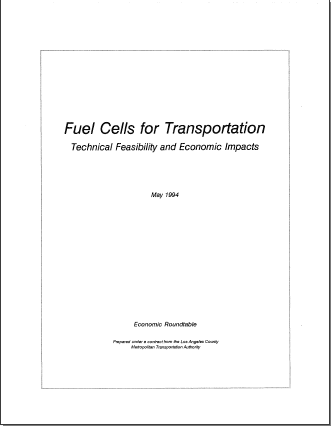SYNOPSIS
Technical Feasibility
Fuel cells are a feasible power system technology for future transit vehicles. The advantages of fuel cells include high efficiency and extremely low vehicle emissions. Progress in fuel cell technology is moving rapidly with limited commercialization expected in this decade. Transit vehicles are a logical first application of fuel cells in transportation.
Timetable and Cost
Presently, fuel cell buses are available only as prototypes. There are two programs with aggressive time tables for producing commercial buses. Both programs expect to reach the commercialization stage by the end of the decade. At that time, buses may be produced at rates larger than 50 buses per year. The target cost for buses by the year 2000 or shortly after is $350,000.
Fuel Logistics
Fundamental to the application of fuel cells to transit is the choice of boarded fuel. Hydrogen and methanol are the favored fuels to store on the vehicle with methanol being converted into a hydrogen rich gas on-board the vehicle. Hydrogen simplifies the fuel cell power plant at the expense of the refueling facility. Methanol simplifies the refueling facility at the expense of the vehicle fuel cell system. Depending on the vehicle mission, range and payload advantages for each fuel can be shown.
Job Creation
The total direct and indirect employment created per $1 Billion of demand for fuel cells is 15,157 jobs. Approximately 77% of this employment is found in the manufacturing sector.
Demand for Fuel Cells
Based on Project California’s “conservative” estimate of electric vehicle use, projected global final demand for fuel cells in the year 2007 could be $9 Billion. This volume of output would support approximately 136,400 total jobs, of which about 105,000 would be generated in manufacturing. The fuel cell industry is potentially of major significance to the economic vitality of individual manufacturing regions, as well as entire national economies.
Potential Job Creation in the Los Angeles Region
Seven of the major input industries for manufacturing fuel cells are strongly represented in the Los Angeles region. These industries account for 52% of total employment generated by fuel cell production. If regional firms from these industries supplied components for a $9 Billion fuel cell market, 70,749 local jobs would be created.
Industries With the Greatest Potential for Job Growth
Industries vary in the number of jobs created as the result of a given investment. Investments in the electrical apparatus sector would produce the largest job gains, followed by composite materials, metal fabrication, and industrial machinery.
Competitive Position of the Los Angeles Region
Even though the Los Angeles region is opening the market for fuel cells through its regulatory program to improve air quality, it has belatedly few firms involved in manufacturing fuel cells. The strongest initiatives to manufacture fuel cells are coming from the east coast of the United States and British Columbia.
Interest of Los Angeles Firms in Diversifying Into New Markets
A majority of high technology firms in the four-county Los Angeles region indicate a high level of interest in developing new products and finding new markets for existing products. Many firms in industries making the types of components required for fuel cells want information about product requirements for new markets.
Role of Government
The public sector will probably be the largest early customer for transportation applications of fuel cells, but firms do not want government to manage competition among firms, or production within firms, to supply those fuel cells. The public sector is challenged to develop a role that is collaborative rather than controlling in helping build a fuel cell industry.
Advanced Technology Transit Bus
The Metropolitan Transportation Authority’s Advanced Technology Transit Bus (ATTB) will probably be the world’s best test bed vehicle for fuel cells, providing a logical focal point for regional efforts to commercialize transportation applications of fuel cells. This could be accomplished by creating a buyers consortium of entities which would pool their buying power to purchase demonstration fuel cells. The consortium could encourage prime contractors that want to sell fuel cells for use in the ATTB Bus to utilize components manufactured in the Los Angeles region.
Increasing the Number of Stakeholders
There are many city and state agencies that have an interest in helping create the 70,000 jobs in the Los Angeles region that might result from a dynamic fuel cell industry. These entities need to be informed of potential economic linkages of this industry to employers in their jurisdictions and be invited to participate in the proposed buyers consortium. This could be leveraged with fuel cell development efforts in other regions, bringing together different technological strength and collective buying power to help build a fuel cell industry.
Chapter Headings:
- Executive Summary
- Fuel Cell Technology and Transit Applications
- Transit Fuel Considerations
- Fuel Cell Bus Availability and Cost
- Input-Output Analysis
- Potential Economic Impacts
- Job Creation Potential by Industry
- Conclusions and Recommendations
- Appendix on Methods/Data.












